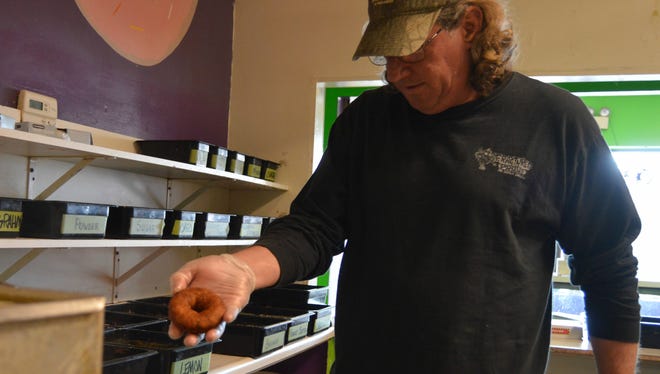Good luck foods to eat on New Year's Eve

Each New Year's, foodies around the world devour specific foods to summon good luck for the next 365 days.
While some traditions call for fruit and others call for noodles, all the edibles connote forward movement, prosperity and health.
Whether or not you are superstitious, take a look at our list of common celebratory eats. If no luck comes your way, at least you will go into the new year with a full belly.

Grapes
New Year's revelers in Spain consume 12 grapes at midnight — one for each month.
The tradition dates back to 1909, when grape growers in the Alicante region of Spain initiated the practice to take care of a grape surplus.
The idea stuck, spreading to Portugal, Venezuela, Cuba, Mexico, Ecuador and Peru. For most, the goal is to swallow all the grapes before the last stroke of midnight, but Peruvians insist on a 13th grape for good measure.
Mike Zygmonski, wine director for SoDel Concepts, suggests pairing the tradition with a nice glass of Spanish Cava (sparkling wine), such as Segura Viudas Reserva Heredad Brut.

Round treats
From Christmas to New Year's Day around the world, cakes, doughnuts, bagels and other baked goods, are enjoyed since they are said to bring a "coming full circle" year ahead.
Italy has chiacchiere, which are honey-drenched balls of pasta dough fried and dusted with powdered sugar. Poland, Hungary, and the Netherlands also eat doughnuts, and Holland has ollie bollen, puffy, doughnut-like pastries filled with apples, raisins and currants.

Long noodles
In China, Japan and other Asian countries, it is customary to eat long noodles, signify longevity, on New Year’s Day. Since the noodles are never to be broken or shortened during the cooking process, the typical preparation is a stir-fry. Check out this recipe by the Pioneer Woman.
Pork
The custom of eating pork on New Year's Eve comes from idea that pigs symbolize progress. The animal pushes forward, rooting itself in the ground before moving, said Doug Ruley, executive chef at SoDel Concepts.
Roast suckling pig is served for the New Year's celebration in Cuba, Spain, Portugal, Hungary, and Austria. Different pork dishes such as pig's feet are enjoyed in Sweden while Germans feast on roast pork and sausages. Pork is also consumed in Italy and the United States, where thanks to its rich fat content, it signifies wealth and prosperity.

Black-eyed peas
Considered lucky for their penny-like appearance and abundance, these peas, are enjoyed in the United States, and traditionally served down South in a dish called hoppin' John, said Gary Papp, owner of Palate in Rehoboth Beach.
Things to do:Where to celebrate New Year's Eve on the Eastern Shore
Things to do:Start the new year with a First Day Hike
Leftover hoppin' John becomes skippin' Jenny, meant to demonstrate frugality and promote prosperity in the new year.
Although he hasn't finalized his New Year's Eve menu, Papp ensures black-eyed peas will be on it.
Fish
Fish on New Year's Eve is like turkey on Thanksgiving.
According to Mark Kurlansky, author of Cod: A Biography of the Fish that Changed the World, cod has been a popular feast food since the Middle Ages. It could be preserved and transported allowing it to reach the Mediterranean and even as far as North Africa and the Caribbean.
Things to do:Penguin Swim turns 25 plus more New Year's Day events on Delmarva
More:The weird things they drop on Delmarva to celebrate the New Year
Today, the Danish eat boiled cod, while in Italy, dried salt cod is enjoyed from Christmas through New Year's. Herring, another frequently preserved fish, is consumed at midnight in Poland and Germany.
The Swedish New Year feast is usually a smorgasbord with a variety of fish dishes, and in Japan, herring roe is consumed for fertility, shrimp for long life, and dried sardines for a good harvest.

Cornbread
Cornbread is especially venerated as a New Year’s Eve treat in the United States, said Papp.
Why? Its color resembles that of gold. To ensure extra luck, some people add in extra corn kernels, emblematic of golden nuggets.

Foods to avoid
In addition to the aforementioned lucky foods, there are also a few to steer clear from.
Lobster, for instance, is said to be a bad idea since they move backwards and could therefore lead to setbacks. Chicken is also discouraged because the bird scratches backwards, which could cause regret or dwelling on the past. Another theory warns against eating any winged fowl because good luck could fly away.
But Toby Gilbert, owner of Gilbert's Provisions in Berlin believes New Year's Eve is all about throwing caution to the wind.
"It should be a night devoted to decadence and indulgence," he said. "You know, one last hooray before becoming a better person."
Gilbert says go for the lobster, worry free, and leave luck up to fate.